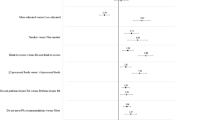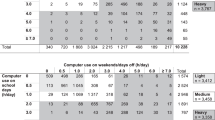Abstract
Physical inactivity contributes to premature mortality and morbidity and increasing prevalences of overweight and obesity in industrialized countries. Computer use is an increasingly common sedentary behaviour, potentially displacing physical activity. Physical activity and computer use were examined in 697 young adults (18–30 years). Energy expenditure estimates were derived from self-reported walking, moderate, and vigorous activity; participants were classified as sedentary, low, moderate, or high in their level of activity. For multivariate analyses, two categories of physical activity were used: inactive (sedentary/low activity; <800 kcal·week−1) or active (moderate/high activity; ≥800 kcal·week−1). Time spent in computer-related activities was summed, and computer use tertiles calculated (<3 hours·week−1; 3–8 hours·week−; >8 hours·week−1). Those in the highest tertile of computer use were most likely to be inactive (p=0.003) and most likely to report computer use as a barrier to physical activity (p<0.001). The majority of those in the top two tertiles of computer use, and of the inactive, preferred obtaining information from computers than from conventional print media. These findings suggest that computer use plays a significant role in the discretionary time of young adults and is negatively associated with physical activity. Computer-mediated communication has potential in disseminating interventions to increase physical activity in young adults.
Similar content being viewed by others
References
National Health and Medical Research Council:Acting on Australia’s Weight: A Strategic Plan for the Prevention of Overweight and Obesity. Canberra, Australia: Australian Government Printing Service, 1997.
Pate R, Pratt M, Blair S, et al: Physical Activity and Public Health. A recommendation from the Centers for Disease Control and Prevention and the American College of Sports Medicine.Journal of the American Medical Association. 1995,273:402–407.
U.S. Department of Health and Human Services:Physical Activity and Health: A Report of the Surgeon General. Atlanta, GA: Public Health Service, Centers for Disease Control and Prevention, National Center for Chronic Disease Prevention and Health Promotion, 1996.
Owen N, Bauman A: The descriptive epidemiology of a sedentary lifestyle in adult Australians.International Journal of Epidemiology. 1992,21:305–310.
Marcus BH, Owen N, Forsyth LH, Cavill NA, Fridinger F: Physical activity interventions using mass media, print media, and information technology.American Journal of Preventive Medicine. 1998,15:362–378.
Sallis JF: Age-related decline in physical activity: A synthesis of human and animal studies.Medicine and Science in Sports and Exercise. 2000,32:1598–1600.
U.S. Department of Commerce:Falling Through the Net II: New Data on the Digital Divide. Washington, DC: U.S. Department of Commerce, 1998.
U.S. Department of Commerce:Falling Through the Net III: Defining the Digital Divide. Washington, DC: U.S. Department of Commerce, 1999.
Australian Bureau of Statistics:Population Survey Monitor. ABS Catalogue No. 4103.0. Canberra, Australia: Australian Bureau of Statistics, 1999.
Broderick D:The Spike. Kew, Victoria: Reed Books Australia, 1997.
Doheny-Farina S:The Wired Neighbourhood. New Haven, CT: Yale University Press, 1996.
Lunenfeld P:The Digital Dialectic—New Essays on New Media. Boston, MA: The MIT Press, 1995.
Williams CD, Sallis JF, Calfas KJ, Burke R: Psychosocial and demographic correlates of television viewing.American Journal of Health Promotion. 1999,13:207–214.
Sidney S, Sternfeld B, Haskell WL, et al: Television viewing and cardiovascular risk factors in young adults: The CARDIA study.Annals of Epidemiology. 1996,6:154–159.
Salmon J, Bauman A, Crawford C, Timperio A, Owen N: The association between television viewing and overweight among Australian adults participating in varying levels of leisure-time physical activity.International Journal of Obesity. 2000,24:600–606.
Science Panel on Interactive Communication and Health:Wired for Health and Well-Being: The Emergence of Interactive Health Communication (Eng TR, Gustafson DH [eds]). Washington, DC: U.S. Department of Health and Human Services, U.S. Government Printing Office, 1999.
Abrams DB, Mills S, Bulger D: Challenges and future directions for tailored communication research.Annals of Behavioral Medicine. 1999,21:299–306.
Kreuter MW, Strecher VJ, Glassman B: One size does not fit all: The case for tailoring print materials.Annals of Behavioral Medicine. 1999,21:276–283.
Bental DS, Cawsey A, Jones R: Patient information systems that tailor to the individual.Patient Education and Counseling. 1999,36:171–180.
Booth ML, Owen N, Bauman A, Gore CJ: Relationship between a 14-day recall measure of leisure time physical activity and a submaximal test of physical work capacity in a population sample of Australian adults.Research Quarterly for Exercise and Sport. 1996,67:221–227.
Booth ML, Owen N, Bauman A, Gore CJ: Retest reliability of recall measures of leisure-time physical activity in Australian adults.International Journal of Epidemiology. 1996,25:153–159.
Leslie E, Owen N, Salmon J, et al: Insufficiently-active Australian college students: Perceived personal, social, and environmental influences.Preventive Medicine. 1999,28:20–27.
Commonwealth Department of Health and Aged Care:National Physical Activity Guidelines for Australians. Canberra, Australia: Commonwealth Department of Health and Aged Care, 1999.
Siegel S:Nonparametric Statistics for the Behavioral Sciences (International Edition), Tokyo, Japan: McGraw-Hill, 1956.
Dietz WH: The role of lifestyle in health: The epidemiology and consequences of inactivity.Proceedings of the Nutrition Society. 1996,55:829–840.
Pate R, Health GW, Dawda M, Trost SG: Associations between physical activity and other health behaviors in a representative sample of U.S. adolescents.American Journal of Public Health. 1996,86:1577–1581.
Australian Bureau of Statistics:Australia at a Glance. ABS Catalogue No. 4309.0. Canberra, Australia: Australian Bureau of Statistics, 1997.
Rimal RN, Flora JA: Interactive technology attributes in health promotion: Practical and theoretical issues. In Street RL, Gold WR, Manning T (eds).Health Promotion and Interactive Technology: Theoretical Applications and Future Directions. Mahwah, NJ: Lawrence Erlbaum Associates, 1997, 19–38.
National Academy of Science:The Unpredictable Certainty: Information Infrastructure through 2000. Washington, DC: National Academy Press, 1996.
Robinson TN, Patrick K, Eng TR, Gustafson D: An evidence-based approach to interactive health communication: A challenge to medicine in the information age.Journal of the American Medical Association. 1998,280:1264–1269.
Ching PLYH, Willett WC, Rimm EB, et al: Activity level and risk of overweight in male health professionals.American Journal of Public Health. 1996,86:25–30.
Williamson DE, Madans J, Anda RF, et al: Recreational physical activity and ten-year weight change in a U.S. national cohort.International Journal of Obesity. 1993,17:279–286.
Hawkins RP, Gustafson DH, Chewning B, Bosworth K, Day PM: Reaching hard-to-reach populations: Interactive computer programs as public information campaigns for adolescents.Journal of Communication. 1987,37:8–28.
Anderson R, Bikson T, Law S, Mitchell B:Universal Access to E-Mail. Feasibility and Societal Implications. Santa Monica, CA: RAND, 1995.
Schneider SJ, Schwartz MD, Fast J: Computerized, telephone-based health promotion: I. Smoking cessation program.Computers in Human Behavior. 1995,11:135–148.
Schneider SJ, Schwartz MD, Fast J: Computerized, telephone-based health promotion: II. Stress management program.Computers in Human Behavior. 1995,11:205–214.
Sproull L, Kiesler S:Connections: New Ways of Working in the Networked Organization. Cambridge, MA: Massachusetts Institute of Technology Press, 1991.
Rhodes F, Fishbein M, Reis J: Using behavioral theory in computer-based health promotion and appraisal.Health Education & Behavior. 1997,24:20–34.
Barker RG:Ecological Psychology. Stanford, CA: Stanford University Press, 1968.
Sallis JF, Owen N: Ecological models. In Glanz K, Lewis FM, Rimer BK (eds),Health Behavior and Health Education: Theory, Research, and Practice (2nd Ed.), San Francisco, CA: Jossey-Bass, 1997, 403–424.
Sallis JF, Bauman A, Pratt M: Environmental and policy interventions to promote physical activity.American Journal of Preventive Medicine. 1998,15:379–397.
Melanson EL, Freedson PS: Validity of the Computer Science and Applications, Inc. (CSA) monitor.Medicine and Science in Sports and Exercise. 1995,27:934–940.
Author information
Authors and Affiliations
Additional information
Preparation of this manuscript was support in part by a National Health and Medical Research Council Public Health Post-Doctoral Fellowship to Michael J. Fotheringham, Ph.D. (#997020).
The authors thank Jo Salmon for her helpful comments.
About this article
Cite this article
Fotheringham, M.J., Wonnacott, R.L. & Owen, N. Computer use and physical inactivity in young adults: Public health perils and potentials of new information technologies. Ann Behav Med 22, 269–275 (2000). https://doi.org/10.1007/BF02895662
Published:
Issue Date:
DOI: https://doi.org/10.1007/BF02895662




